September 27, 2022
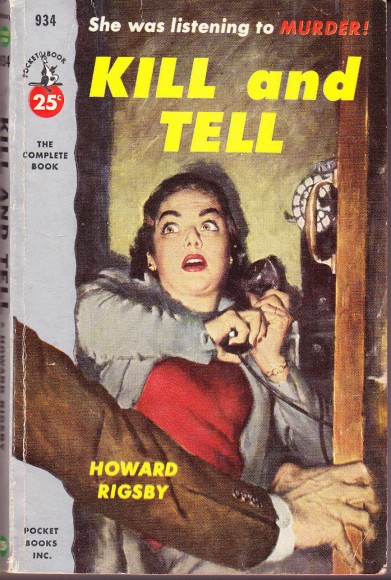 Long ago on this here blog (the ol’ Spiked Punch, around longer than makes any sense, haha), I had a post with two quotes – in one post! What was I thinking? – from the Howard Rigsby book, Kill and Tell, the Pocket Book edition, 1953. Well, recently, I decided to re-read said book, brought back to it by the swell cover and the name, and cause I didn’t remember exactly how it turned out. I’d also forgotten what a, interesting, mid-last-century pocket-y mystery it is, just as the protagonist Tim Wilde is perhaps more thinky, or considered (if that makes sense) then some of his more hard-boiled shamuses of the time. Plus, it ends fairly sadly (not so strange, but the way it gets there I found different enough to be interesting). There are two murders, small town shenanigans, car smacks, monkeys (!!), piano playing, and more. Worth checking out. Plus the nice usage of the word “mottled” in the below!
Long ago on this here blog (the ol’ Spiked Punch, around longer than makes any sense, haha), I had a post with two quotes – in one post! What was I thinking? – from the Howard Rigsby book, Kill and Tell, the Pocket Book edition, 1953. Well, recently, I decided to re-read said book, brought back to it by the swell cover and the name, and cause I didn’t remember exactly how it turned out. I’d also forgotten what a, interesting, mid-last-century pocket-y mystery it is, just as the protagonist Tim Wilde is perhaps more thinky, or considered (if that makes sense) then some of his more hard-boiled shamuses of the time. Plus, it ends fairly sadly (not so strange, but the way it gets there I found different enough to be interesting). There are two murders, small town shenanigans, car smacks, monkeys (!!), piano playing, and more. Worth checking out. Plus the nice usage of the word “mottled” in the below!
I went up the stairs and he was standing there on the landing in a dressing gown. He had, as usual, a drink in his hand, a highball. His face looked mottled and feverish. “Well, I made it,” he said. “I made the inquest.”
“How was it?”
“Come in here,” he said. He turned and went into the sitting room and I followed him. He waved a fresh bottle of Scotch. “Pour yourself a drink.”
–Howard Rigsby, Kill and Tell
July 26, 2022
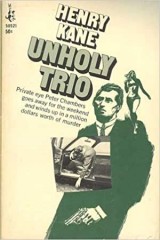 Our final stop (don’t miss The Unholy Trio Cocktail Talks Part I and Part II, by the way) in my latest Henry Kane yarn featuring two-fisted sharp-dressing quick-shooting kiss-a-lot-of-girls PI Peter Chambers. This quote almost didn’t make it to the site, as I wasn’t sure it was Cocktail Talk-y enough, but really, any time someone in a book is drinking a Rob Roy, it needs Cocktail Talking. And a Dry Rob Roy (not sure I’ve heard that much)? Forget about it! Read the other two in the series to get more book details, but not before you drink up the below.
Our final stop (don’t miss The Unholy Trio Cocktail Talks Part I and Part II, by the way) in my latest Henry Kane yarn featuring two-fisted sharp-dressing quick-shooting kiss-a-lot-of-girls PI Peter Chambers. This quote almost didn’t make it to the site, as I wasn’t sure it was Cocktail Talk-y enough, but really, any time someone in a book is drinking a Rob Roy, it needs Cocktail Talking. And a Dry Rob Roy (not sure I’ve heard that much)? Forget about it! Read the other two in the series to get more book details, but not before you drink up the below.
“What are you drinking? Lunch is on me.”
“Why?”
“I’m going to get paid.”
“That you are.” I had brought a blank check. “Dry Rob Roy,” I said to the waiter. The menus were already on the table.
“Congratulations,” Arnie said.
“For what?”
“I believe you got married.”
“Oh. Thanks.” Miranda wouldn’t have told him. She was as cozy with information as Cosa Nostra. “How do you know?” I said.
“How do I know? Heck, there was a spread in every newspaper.”
“Yes, there was, wasn’t there?” My drink arrived and I drank it, quickly.
–Henry Kane, The Unholy Trio
Tags: bitters, Cocktail Talk, dry Rob Roy, Henry Kane, Part III, Peter Chambers, Rob Roy, Scotch, sweet vermouth, The Unholy Trio
Posted in: bitters, Cocktail Talk, Scotch, vermouth
June 21, 2022
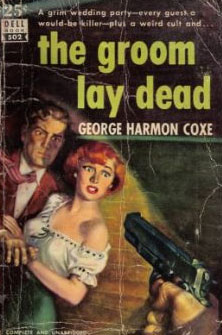 It was recently my anniversary (thank you to my wife for marrying me!), which seemed the perfect time to re-read the 1944 mystery by George Harmon Coxe (a fairly well-known mystery writer from mid-last-century) called The Groom Lay Dead! It’s a nicely-paced (not breath-takingly-paced like Day Keene, but it keeps things moving) mystery around the death of a somewhat asshole-ish rich guy, with our protagonist being a slightly shell-shocked (this the WW II era) play director. So, there’s glamorous folks, an interesting upstate New York Finger Lakes setting, a few potentially shady (or moreso!) potential murderers, as well as a sort-of cult-ish health farm run by a hypnotic man – always a good addition. Worth checking out, especially if you can get the cover pictured here. I had a The Groom Lay Dead Cocktail Talk on here after the first time I read it, many years in the past (do, don’t miss that, ya’hear?), but I’d forgotten about this minor character I liked, and felt he (George Vernon, vaguely trapped up the health farm/cult) and his night out deserved a second Cocktail Talk quote.
It was recently my anniversary (thank you to my wife for marrying me!), which seemed the perfect time to re-read the 1944 mystery by George Harmon Coxe (a fairly well-known mystery writer from mid-last-century) called The Groom Lay Dead! It’s a nicely-paced (not breath-takingly-paced like Day Keene, but it keeps things moving) mystery around the death of a somewhat asshole-ish rich guy, with our protagonist being a slightly shell-shocked (this the WW II era) play director. So, there’s glamorous folks, an interesting upstate New York Finger Lakes setting, a few potentially shady (or moreso!) potential murderers, as well as a sort-of cult-ish health farm run by a hypnotic man – always a good addition. Worth checking out, especially if you can get the cover pictured here. I had a The Groom Lay Dead Cocktail Talk on here after the first time I read it, many years in the past (do, don’t miss that, ya’hear?), but I’d forgotten about this minor character I liked, and felt he (George Vernon, vaguely trapped up the health farm/cult) and his night out deserved a second Cocktail Talk quote.
Apparently it had been quite a while since George Vernon had been out and he’d made up his mind to enjoy himself. He had four drinks at the bar in addition to the two he’d had at Yager’s house: he had another Scotch and soda with his dinner and called for brandy with his coffee. Parks was doing all right, too. He got a lot of laughs of Vernon, who long ago had insisted that we call him George.
— George Harmon Coxe, The Groom Lay Dead
October 26, 2021
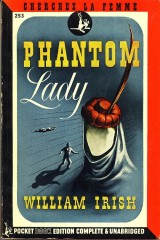 I went down a large Cornell Woolrich hole at one point in my life, and in some ways never came out (perhaps I’m not in as deep as I once was, which isn’t to say my liking of books by said author is less, but maybe to say I’ve read such a fair amount of those available that there aren’t that many more readily available) – heck, check out the past Cornell Woolrich Cocktail Talks for evidence. There are a fair few of them! You’ll get lots of background on this, the noir-y-est (in many ways – I mean, no mystery writer uses the word “black” in more titles for a start, but also he’s such a master of psychological dark moods and mental, as well as action-driven, thrillers that seem going down a dark path) of the pulp writers, perhaps. He also wrote under a couple pseudonyms, the best-known being William Irish, under-which name he became famous enough that I have a copy of The Best of William Irish which I was recently re-reading. Featuring two full-length reads and a handful of stories, the book’s highlight may well be “Rear Window” (from which the legendary movie was made, which you should re-watch right now), which, funny enough, I think was pub’d under Cornell’s own name originally (and originally called “It Had to be Murder”). But if you have a story which a famous movie is based on, you work it in. The whole collection starts with perhaps the most famous William Irish-monikered tale (though that could be debated), the novel Phantom Lady, which I am also lucky enough to have as a standalone book, and which was also made into a movie in 1944, a movie I haven’t seen, but would love to! The book’s chapters all countdown to an execution (28 Days Before the Execution, etc.), which gives an insight into the plot: a man is accused – falsely, we know – of the murder of his wife, with only one possible way to convince the police he’s innocent, finding of a missing woman who can place him at a bar at a particular time. It’s a good read and then some, keeping you moving and twisting around this way and that way, with a few more murders and lots of surprises. Having a bar with a key role doesn’t hurt, either, and neither does the mention of Jack Rose cocktails, among others, in the below Cocktail Talk quote.
I went down a large Cornell Woolrich hole at one point in my life, and in some ways never came out (perhaps I’m not in as deep as I once was, which isn’t to say my liking of books by said author is less, but maybe to say I’ve read such a fair amount of those available that there aren’t that many more readily available) – heck, check out the past Cornell Woolrich Cocktail Talks for evidence. There are a fair few of them! You’ll get lots of background on this, the noir-y-est (in many ways – I mean, no mystery writer uses the word “black” in more titles for a start, but also he’s such a master of psychological dark moods and mental, as well as action-driven, thrillers that seem going down a dark path) of the pulp writers, perhaps. He also wrote under a couple pseudonyms, the best-known being William Irish, under-which name he became famous enough that I have a copy of The Best of William Irish which I was recently re-reading. Featuring two full-length reads and a handful of stories, the book’s highlight may well be “Rear Window” (from which the legendary movie was made, which you should re-watch right now), which, funny enough, I think was pub’d under Cornell’s own name originally (and originally called “It Had to be Murder”). But if you have a story which a famous movie is based on, you work it in. The whole collection starts with perhaps the most famous William Irish-monikered tale (though that could be debated), the novel Phantom Lady, which I am also lucky enough to have as a standalone book, and which was also made into a movie in 1944, a movie I haven’t seen, but would love to! The book’s chapters all countdown to an execution (28 Days Before the Execution, etc.), which gives an insight into the plot: a man is accused – falsely, we know – of the murder of his wife, with only one possible way to convince the police he’s innocent, finding of a missing woman who can place him at a bar at a particular time. It’s a good read and then some, keeping you moving and twisting around this way and that way, with a few more murders and lots of surprises. Having a bar with a key role doesn’t hurt, either, and neither does the mention of Jack Rose cocktails, among others, in the below Cocktail Talk quote.
He said, “I had a Scotch and water. I always have that, never anything else. Give me just a minute now, to see if I can get hers. It was all the way down near the bottom –“
The barman came back with a large tin box.
Henderson said, rubbing his forehead, “There was a cherry left in the bottom of the glass and – “
“That could be any one of six drinks. I’ll get it for you. Was the bottom stemmed or flat? And what color was the dregs? If it was a Manhattan the glass was stemmed and dregs, brown.”
Henderson said, “It was a stem-glass, she was fiddling with it. But the dregs weren’t brown, now, they were pink, like.”
“Jack Rose,” said the barman briskly. “I can get it for you easy, now.”
–Cornell Woolrich (writing as William Irish), Phantom Lady
Tags: apple brandy, applejack, Bars, Cocktail Talk, Cornell Woolrich, grenadine, Jack Rose, lemon, Manhattan, Phantom Lady, Scotch, Scotch and water, sweet vermouth, Whiskey, William Irish
Posted in: Bars, Brandy, Cocktail Talk, Manhattan, Scotch, vermouth, Whiskey
September 28, 2021
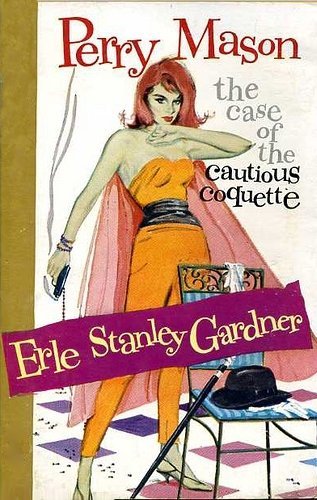 Recently (not today recent, but just weeks ago), I had a few Cocktail Talks from the A.A. Fair book Owls Don’t Blink (you can read Part I and Part II as desired). A.A. Fair of course being an alias of Erle Stanley Gardner, who is/was/will be mostly famous for his series of books featuring dashing and mystery-solving attorney Perry Mason. I’ve written before here on Spiked Punch (check out past Erle Cocktail Talks for evidence) how I generally like the Perry Mason television show better than the books, in a twist, and how I also tend to like the A.A. Fair books better. Hey, I’m strange! I don’t dislike the Perry Mason books, but sometimes our loveable lawyer is a little too, oh, cool? I dunno. I will say this: the Perry Mason books are worth reading, A: to make up your own mind, B: cause some (like The Case of the Cautious Coquette) are dandy reads, C: they all tend to move fast and frolicsome, and D: the versions in the 40s, 50s, maybe even early 60s usually have outstanding covers. This one, featuring our red-headed heroine holding a smoking gun and wearing a smoking pantsuit, is no different. The tale itself features a mysterious letter, woman, murder, gun, car wreck, and more. And an un-mysterious drink for Perry.
Recently (not today recent, but just weeks ago), I had a few Cocktail Talks from the A.A. Fair book Owls Don’t Blink (you can read Part I and Part II as desired). A.A. Fair of course being an alias of Erle Stanley Gardner, who is/was/will be mostly famous for his series of books featuring dashing and mystery-solving attorney Perry Mason. I’ve written before here on Spiked Punch (check out past Erle Cocktail Talks for evidence) how I generally like the Perry Mason television show better than the books, in a twist, and how I also tend to like the A.A. Fair books better. Hey, I’m strange! I don’t dislike the Perry Mason books, but sometimes our loveable lawyer is a little too, oh, cool? I dunno. I will say this: the Perry Mason books are worth reading, A: to make up your own mind, B: cause some (like The Case of the Cautious Coquette) are dandy reads, C: they all tend to move fast and frolicsome, and D: the versions in the 40s, 50s, maybe even early 60s usually have outstanding covers. This one, featuring our red-headed heroine holding a smoking gun and wearing a smoking pantsuit, is no different. The tale itself features a mysterious letter, woman, murder, gun, car wreck, and more. And an un-mysterious drink for Perry.
He arose as Mason entered the room, said, “Mr. Mason, the lawyer?”
“That’s right.”
The man extended his hand. “I’m Stephen Argyle. I’ve very glad to meet you. I have heard about you. Won’t you sit down and join me in a drink?”
He was thin to the point of being bony, with long fingers, high cheekbones, bleached out eyes, think hair which was well shot with gray. He wore glasses which clamped on the bridge of a high nose with a black ribbon hanging from the side, giving him an expression of austere power.
Mason said, “Thank you. I’ll have a Scotch and soda, please.”
Argyle nodded to the butler, who walked over to the portable bar, dropped ice cubes in a glass, mixed a Scotch and soda, and wordlessly handed it to Mason.
–Erle Stanley Gardener, The Case of the Cautious Coquette
February 5, 2021
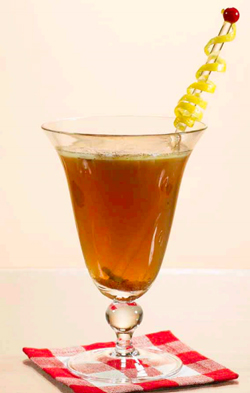 Yes, I agree with you! This warming winner does deserve a much more imaginative and inventive and intriguing and just better name. But I suppose that on occasion being straightforward isn’t a bad thing – it is cold outside, so something hot is needed. And this drink does have spices and Scotch. So that name isn’t wrong by any means, but, c’mon, the spice layers here, allspices, cloves, nutmeg, and the toddy-ness, and the butter, and a little smooch of sweet, and Scotch (did I mention that?), altogether raising this drink into the high heights of hot drinkness, the tempting tops of cold-curing drink mountain, the level of a drink that needs a name to match. It should have been called Hercules! However, it was first called Hot Spiced Scotch I think in Applegreen’s Bar Book, or at least that’s where I saw it (my edition is copyright 1909, published by the Hotel Monthly Press, though an earlier edition came out in 1899), and since it’s been called that for now over 100 years, let’s keep it that way, shall we? We shall.
Yes, I agree with you! This warming winner does deserve a much more imaginative and inventive and intriguing and just better name. But I suppose that on occasion being straightforward isn’t a bad thing – it is cold outside, so something hot is needed. And this drink does have spices and Scotch. So that name isn’t wrong by any means, but, c’mon, the spice layers here, allspices, cloves, nutmeg, and the toddy-ness, and the butter, and a little smooch of sweet, and Scotch (did I mention that?), altogether raising this drink into the high heights of hot drinkness, the tempting tops of cold-curing drink mountain, the level of a drink that needs a name to match. It should have been called Hercules! However, it was first called Hot Spiced Scotch I think in Applegreen’s Bar Book, or at least that’s where I saw it (my edition is copyright 1909, published by the Hotel Monthly Press, though an earlier edition came out in 1899), and since it’s been called that for now over 100 years, let’s keep it that way, shall we? We shall.
Hot Spiced Scotch
1/2 ounce Simple Syrup
1/2 teaspoon ground allspice
3 to 4 whole cloves
2 ounces Scotch
3-1/2 ounces water
1/2 teaspoon butter
1/4 teaspoon freshly grated nutmeg for garnish
Lemon twist for garnish
1. Heat a sturdy goblet by running it under warm water, then drying it quickly.
2. Add the simple syrup, allspice, and cloves to a cocktail shaker. Using a muddler or wooden spoon, muddle well.
3. Add the Scotch to the shaker. Swirl the contents together, and then strain into the warm goblet.
4. Heat the water in a small saucepan or in the microwave. Pour the hot water into the goblet. Add the butter and stir a couple of times (not once for every year between now and 1909, though).
5. Top the drink with the nutmeg and the lemon twist.
Tags: allspice, butter, cloves, cocktail, Cocktail Recipes, Friday Night Cocktail, hot drinks, Hot Spiced Scotch, lemon twist, nutmeg, Scotch, simple syrup, water, What I’m Drinking
Posted in: Cocktail Recipes, Dark Spirits, Recipes, Scotch, What I'm Drinking
December 1, 2020
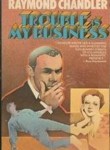 As said in the “Goldfish” Cocktail Talk Part I, this particular Raymond Chandler story (from the Trouble Is My Business and Other Stories collection, and also don’t miss the “Trouble Is My Business” Part I and Part II Cocktail Talks, and for that matter, don’t miss other past Raymond Chandler Cocktail Talks) winds its way eventually up the coast all the way to Seattle, and so is nearly automatically near-and-dear to me. But it starts down the coast a ways, and also starts a little rough for one character (that’s your warning – the below quote is a little, oh, violent at the beginning), but then heads to Brooklyn. With Brooklyn Scotch, which, I have to admit, I’ve never heard of! So, now I’m very curious, and hoping the below makes you curious, too, and that curiosity leads to some Brooklyn Scotch history.
As said in the “Goldfish” Cocktail Talk Part I, this particular Raymond Chandler story (from the Trouble Is My Business and Other Stories collection, and also don’t miss the “Trouble Is My Business” Part I and Part II Cocktail Talks, and for that matter, don’t miss other past Raymond Chandler Cocktail Talks) winds its way eventually up the coast all the way to Seattle, and so is nearly automatically near-and-dear to me. But it starts down the coast a ways, and also starts a little rough for one character (that’s your warning – the below quote is a little, oh, violent at the beginning), but then heads to Brooklyn. With Brooklyn Scotch, which, I have to admit, I’ve never heard of! So, now I’m very curious, and hoping the below makes you curious, too, and that curiosity leads to some Brooklyn Scotch history.
They had been burned raw on the soles. There was a smell of scorched flesh in spite of the open window. Also, a smell of scorched wood. An electric iron on a desk was still connected. I went over and shut it off.
I went back to Kathy Home’s kitchen and found a pint of Brooklyn Scotch in the cooler. I used some of it and breathed deeply for a little while and looked out over the vacant lots. There was a narrow cement walk behind the house and green wooden steps down to the street.
–Raymond Chandler, “Goldfish”
November 17, 2020
 Well, when I earlier (as in last week pals) had a “Trouble is My Business” Cocktail Talk post, I’ll bet those of you who bet made a bet at your local bookie that I’d have another one on its heels, and, well, here we are! I feel we’re gonna spend a few weeks with Mr. Chandler and Mr. Marlowe now that we’ve opened the tab. But let’s not get ahead of ourselves! Today, we’d still in the story “Trouble is My Business,” and we’re still in Scotch land – not a bad land to be within.
Well, when I earlier (as in last week pals) had a “Trouble is My Business” Cocktail Talk post, I’ll bet those of you who bet made a bet at your local bookie that I’d have another one on its heels, and, well, here we are! I feel we’re gonna spend a few weeks with Mr. Chandler and Mr. Marlowe now that we’ve opened the tab. But let’s not get ahead of ourselves! Today, we’d still in the story “Trouble is My Business,” and we’re still in Scotch land – not a bad land to be within.
He opened the door, went out, shut it, and I sat there still holding the telephone, with my mouth open and nothing in it but my tongue and a bad taste on that.
I went out to the kitchen and shook the Scotch bottle, but it was still empty. I opened some rye and swallowed a drink and it tasted sour. Something was bothering me. I had a feeling it was going to bother me a lot more before I was through.
–Raymond Chandler, Trouble is My Business
 Long ago on this here blog (the ol’ Spiked Punch, around longer than makes any sense, haha), I had a post with two quotes – in one post! What was I thinking? – from the Howard Rigsby book, Kill and Tell, the Pocket Book edition, 1953. Well, recently, I decided to re-read said book, brought back to it by the swell cover and the name, and cause I didn’t remember exactly how it turned out. I’d also forgotten what a, interesting, mid-last-century pocket-y mystery it is, just as the protagonist Tim Wilde is perhaps more thinky, or considered (if that makes sense) then some of his more hard-boiled shamuses of the time. Plus, it ends fairly sadly (not so strange, but the way it gets there I found different enough to be interesting). There are two murders, small town shenanigans, car smacks, monkeys (!!), piano playing, and more. Worth checking out. Plus the nice usage of the word “mottled” in the below!
Long ago on this here blog (the ol’ Spiked Punch, around longer than makes any sense, haha), I had a post with two quotes – in one post! What was I thinking? – from the Howard Rigsby book, Kill and Tell, the Pocket Book edition, 1953. Well, recently, I decided to re-read said book, brought back to it by the swell cover and the name, and cause I didn’t remember exactly how it turned out. I’d also forgotten what a, interesting, mid-last-century pocket-y mystery it is, just as the protagonist Tim Wilde is perhaps more thinky, or considered (if that makes sense) then some of his more hard-boiled shamuses of the time. Plus, it ends fairly sadly (not so strange, but the way it gets there I found different enough to be interesting). There are two murders, small town shenanigans, car smacks, monkeys (!!), piano playing, and more. Worth checking out. Plus the nice usage of the word “mottled” in the below!


























